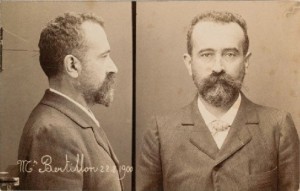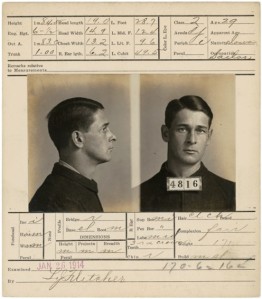Meet the inventor of the mug shot: Frenchman, police officer and biometrics researcher who developed anthropometry which was beneficial to police officers in criminal identification.
One can only see what one observes, and one observes only things which are already in the mind. Alphonse Bertillon (4.24.1853 to 2.13.1914).
HISTORY OF ALPHONSE BERTILLON
Alphonse Bertillon was born in Paris, France. He had attempted a number of jobs before being called to serve with the French army at the age of 22. After serving in the army and not having a high level of education, his father and a medical professor Louis Bertillon, had influenced his hire into the Paris police. Bertillon’s brother, Jacques, also became successful including stepping into his father’s role after he died. Bertillon’s mother, Zoé, died very young at the age of 34 from the effects of a fever she was unable to break.
Some may have considered Bertillon to be a bit aloof since he wasn’t gifted with social skills. He was intelligent and he presented himself well. While working as a clerk for the Parisian police, it was Bertillon’s chief goal to help promote a system that could identify repeat offenders more expeditiously. Bertillon developed a method of identification which became known as Bertillonage and although repeat offenders could become identified, in time, this process was proven to be flawed when measurements were not taken accurately. For example, although consideration was given to a host of different measurements of any one particular individual in comparison to one element of measurement such as head size, imagine two people having the same measurement across their foreheads. Ultimately, this method would be replaced by a more effective measure known as fingerprinting. Noteworthy, Bertillon didn’t just rely on body measurements; he also used other physical characteristics such as scarring and personality factors.
Bertillon actually had developed a good idea to create a system that could identify someone who might be a repeat offender which, again, was a large part of his goal. It was found, though, that a person’s measurements could change just through the process of aging. Once fingerprinting came along, some of his fame was extinguished although he did incorporate the fingerprinting process into his method of identification. Fingerprinting, however, is quite unique per person.
In being a product of a prestigious family and the fact there were other physicians in his family, Bertillon was never considered to be another diamond. However, that being said, through the use of his experience with the police department, he became a criminologist and this would bring him fame in another type of laboratory.
Bertillon died at the age of 61 in Switzerland. Although his method soon faded after fingerprinting was adopted, he or his ego didn’t embrace the replacement identification method. Regardless, Bertillon is still viewed as the one who broke new ground into criminal identification.
The photo above depicts a classroom where the subject of Bertillon’s method of criminal identification is being taught. (Source: http://Wikipedia.)
WHAT IS BIOMETRICS?
The study of the characteristics and traits of a human being for identification purposes is the simple explanation of biometrics. There are different types of biometrics dependent upon the need. Obviously, with computer science, this method is an identifier of sorts that reaches into a database of information. Through Bertillon’s research, he developed anthropometry which is further described below.
The illustration above is from an article entitled, “The Speaking Portrait,” from “Pearson’s Magazine,” published in 1901, which depicts Bertillon’s principles of anthropometry. (Source: http://Wikipedia; this image is in the public domain because copyright has expired.)
WHAT IS ANTHROPOMETRY?
Anthropometry is essentially a technique used that would measure a person, hence the study of body measurements. In the 1880s, Bertillon opined that every individual would have different measurable physical characteristics.
The measurements also included other elements such as eyes and ears. This information was stored on cards which also contained a photo of the offender and processed into a filing system. Because Bertillon was able to identify over 200 offenders in 1884, other countries adopted his method. When this method was used in the United States, the centralized filing system of Bertillon cards was housed in Chicago.
The image above was a self-portrait taken of Bertillon August 22, 1900. (Source: http://Wikipedia; this image is in the public domain because the copyright has expired.)
THE MUG SHOT
Bertillon also developed the standard of an offender’s mug shot and taking pictures of evidence prior to a crime scene being touched. Bertillon helped to shape other types of forensics practices, one of which could include examining whether a person’s signature on a document is forged or not essentially known as handwriting analysis today. He also contributed to the subject of preserving footprints.
Before Bertillon’s method of measurements was used, other than a system that wasn’t well organized, notes, photographs, or other less measures were used to try to identify or catch a criminal. Bertillon’s method was used for nearly three decades before fingerprinting came into use and at least his method was a form of advancement as well as an improved system. His development of the mug shot, however, is still deployed today.
The above image is an example of a Bertillon card identifier. (Source: http://research.archives.gov/description/646350.) This image describes John Welshouse, a sailor, who was arrested at the age of 29 for violating the White Slavery Act in New Orleans, better known as prostitution. He received one year and one day for his sentence to have expired on January 22, 1915. Interestingly and unrelated to the main subject, Welshouse’s wife made inquiry of him to the prison’s warden, who wrote back indicating his sentence was reduced and he was provided transportation to Milwaukee, Wisconsin.
The image is an example of one of Bertillon’s “cards” which has all the indicators represented of measurements taken to secure Welshouse’s identity and obviously, the mug shot image is of great benefit.



